Appx B-2_Public Comments and CDC Response
Appx B-2_Public Comments and CDC Response.docx
Assessment & Monitoring of Breastfeeding-Related Maternity Care Practices in Intrapartum Care Facilities in the United States and Territories
Appx B-2_Public Comments and CDC Response
OMB: 0920-0743

Appendix B-2
Summary of Public Comments and CDC Response
Assessment and Monitoring of Breastfeeding-Related Maternity Care Practices in Intrapartum Care Facilities in the United States and Territories
Federal Register Notice: A 60-day Notice was published in the Federal Register on May 10, 2010, Vol. 75, No. 89, pp. 25862-25863.
CDC Acknowledgement for Public Comments and Letters of Support:
Hello,
Thank you for your comments concerning the CDC 60 Day Federal Register Notice for OMB No. 60-Day 10-0743, Assessment and Monitoring of Breastfeeding-Related Maternity Care
Practices in Intra-partum Care Facilities in the United States and
Territories. We have given the concerns you described careful consideration. For further information regarding the unique mission of CDC, please refer to our website at www.cdc.gov.
Thank you for your interest.
CDC
Public Comment #1
From:
[email protected] [mailto:[email protected]]
Sent:
Wednesday, May 12, 2010 4:18 PM
To:
OMB-Comments (CDC)
Subject:
proposed data collection for mPINC
I am pleased me to be able to provide input as to the importance of the mPINC survey. I am the director of a program that provides home visiting services to women and infants during the prenatal period and continuing until the child is age 2. All the women and infant we serve are enrolled in AL Medicaid. Our program is a comprehensive one that addresses the following: health of both mother and infant/child; life course development for the mother; infant/child development; and use of community resources . One of the primary barriers (sometimes insurmontable) in assisting our patients to make decisions that improve health for themselves and their infant/child, and to ensure that their infant/child meets the developmental benchmarks is lack of breastfeeding support by staff in all three hospitals in our city. This survey may cause the facilities to question whether their care is meeting the needs of breast feeding patients.
I believe the mPINC survey is essential for these hospitals to value making the changes necessary for improving breastfeeding rates for our AL Medicaid population. Therefore, my comments on a-d listed in the FRN are :
(a) Collection of the information is essential.
(b) Ensure that the correct personnel are named to identify where these data are within the agency. Use nurse managers,. or others who have knowledge of how to obtain these required data in an efficient manner.
(c) Target survey participants so that accuracy of responses is enhanced and "filtered perceptions" are not used to give a picture of agency performance. Dividing the survey into sections specifically for antenatal, intrapartum, postpartum and well- baby nursery (couplet care is not implemented in our hospitals).
(d) Use an electronic survey that is easy to complete to improve participation rate.
Thank you for reading my suggestions.
Gene Hamrick, RN, EdD
Director, Nurse-Family Partnership
Gift of Life Foundation
1348 Carmichael Way
Montgomery, AL 36106
(334) 273-7817
Public Comment #2
-----Original Message-----
From: DeMarco, Patrice A. [mailto:[email protected]]
Sent: Wednesday, May 12, 2010 8:51 AM
To: OMB-Comments (CDC)
Subject: mPINC survey 2009
Thank you for continuing to moniter facilities that provide maternity care for families. This information on how well these facilities provide evidenced based care is critical to improving our care for these families. The fact that the weight of the government and specifically that arm of the government interested in preventing disease is interested in what and how our facilities are doing to support breastfeeding lends credibilty that breastfeeding is important. Administrators love to compare their hospital with others. It gives weight to those in hospitals who work to convince administrators that breastfeeding support is important to their customers and our public health.
It is invaluable that the CDC continue to moniter and publish this data.
One concern that I had about our 2007 survey - I have worked as the lactation consultant for our hospital, am the most familiar with our maternity care practices and I wasn't involved in the answering the questionairre - neither were the managers of our maternity units or the clinical director. I found that some of the answers were not quite accurate but could not find who completed the survey. I was given an opportunity to answer the 2009 questionairre but others had already filled it out and more were going to be given the opportunity to do so. I can hear your reasons that the responder be kept confidential so that they might answer more freely - but I wonder if the response is always accurate, that the responder may make the institution sound better or worse, depending on how knowledgeable the responder is on the actual practices.
Patrice DeMarco
FAHC, Burlington,Vermont
Public Comment #3
From:
[email protected] [mailto:[email protected]]
Sent:
Wednesday, May 12, 2010 1:03 PM
To:
OMB-Comments (CDC)
Subject:
Proposed data collection-60 day-10-0743
Comments on [60 Day-10-0743]
CDC Assessment and Monitoring of Breastfeeding-Related Maternity Care Practices in Intra-partum Care Facilities in the United States and Territories
(OMB Control No. 0920-0743, Exp.10/31/2010)-Revision-National Center for Chronic Disease Prevention and Health Promotion (NCCDPHP), Centers for Disease Control and Prevention (CDC).
From: Marsha Walker, RN, IBCLC
Executive Director, National Alliance for Breastfeeding Advocacy
254 Conant Rd
Weston, MA 02493
781 893-3553
Fax 781 893-8608
Date: May 12, 2010
The comments below represent strong support of the Assessment and Monitoring of Breastfeeding-Related Maternity Care Practices in Intra-partum Care Facilities in the United States and Territories.
1. The proposed collection of information is necessary for the proper function of the Centers for Disease Control and Prevention, and will have enormous practical utility. Every baby must be fed, and abundant research supports the importance of the US National Health Goals including >75% of babies are exclusively breastfeeding at hospital discharge. Maternity care practices are clearly relevant to breastfeeding outcomes. 1, 2 Formula-feeding far in excess of that medically necessary is financially costly to the US taxpayer3-5, employers6 and families4, 7, 8. Formula-feeding is associated with higher rates of morbidity and mortality in the USA.9-11 Recent research reveals the extent of influence that breastfeeding has on the health of the nation. If 90% of US families could comply with medical recommendations to breastfeed exclusively for 6 months, the United States would save $13 billion per year and prevent an excess 911 deaths.12
The current versions of this study have yielded compelling data on the geographic disparities in breastfeeding support and services offered by birthing hospitals in the US.13 It is clear that not all mothers receive optimal evidence-based lactation support and services. Maternity care practices in hospitals and birth centers throughout the intrapartum period, such as staff education, ensuring mother-newborn skin-to-skin contact, keeping mother and newborn together, and not giving supplemental feedings to breastfed newborns unless medically indicated, can positively influence breastfeeding behaviors during a period critical to the successful establishment of lactation. Widespread use of maternity practices that are not evidence-based and that are known to interfere with breastfeeding were revealed in this study. For example, 24% of birth facilities reported supplementing more than half of healthy, full-term, breastfed newborns with something other than breast milk during the postpartum stay, a practice shown to be unnecessary and detrimental to breastfeeding. In addition, 70% of facilities reported giving breastfeeding mothers gift bags containing infant formula samples, a practice that reduces exclusive breastfeeding and markets pricey products to a vulnerable population.
2. The agency’s estimate of the burden of the proposed collection of information is accurate because the agency has solid data on the time and costs of the first survey conducted.
3. The existing survey methodology was sound, and the data collected was very useful. Over 80% of facilities contacted responded to the first two surveys. The quality of the data could be improved if there were an independent method of validating the reported data, perhaps a survey of mothers who utilized each maternity facility. Adding more birth data elements (for example, rates of primary and repeat Cesarean sections, labor induction, and select interventions including epidural anesthesia) would improve the ability to correlate breastfeeding outcomes with birth practices.
4. Existing data elements already collected by the facility, state health department, Medicaid or other entities would add to the usefulness of the surveys. Automated data collection would also facilitate more thorough and detailed interpretation of the data by researchers. Hospitals collect and publish data on some of these interventions anyway, and a regular survey would encourage the facilities to standardize reporting of these elements and integrate the elements into other electronic medical-record systems.
5. Results from the existing survey have already yielded increased interest by hospitals in improving their practices. In Massachusetts, 14 hospitals have formed a collaborative to improve their mPINC scores. Two summits have been conducted in April 2009 and again in April 2010 for administrators of all Massachusetts hospitals to explore strategies for enhancing breastfeeding support and services. Results from the US federally sponsored mPINC Survey were leveraged to bring together facility leaders who influence hospital breastfeeding practices to improve adherence to breastfeeding standards of care. The breastfeeding summits resulted in administration from hospitals representing over 85% of the births in Massachusetts sharing their work in improving their mPINC scores.
The mPINC surveys have acted as a catalyst to motivate hospitals to improve their lactation care and services and have been one of the most useful CDC projects for affecting breastfeeding duration and exclusivity rates. It should definitely be repeated as a tracking mechanism to monitor improvement and as a means to identify where hospitals need to improve breastfeeding care for their patients.
1. DiGirolamo AM, Grummer-Strawn LM, Fein S. Maternity care practices: implications for breastfeeding. Birth. Jun 2001;28(2):94-100.
2. Shealy K, R L, S B-D, LM G-S. The CDC Guide to Breastfeeding Interventions. Atlanta: US Department of Health and Human Services, Centers for Disease Control and Prevention; 2005.
3. Ball TM, Wright AL. Health Care Costs of Formula-feeding in the First Year of Life. Pediatrics. April 1, 1999 1999;103(4):870-876.
4. Tuttle CR, Dewey KG. Potential cost savings for Medi-Cal, AFDC, food stamps, and WIC programs associated with increasing breast-feeding among low-income Hmong women in California. J Am Diet Assoc. Sep 1996;96(9):885-890.
5. Smith JP, Thompson JF, Ellwood DA. Hospital system costs of artificial infant feeding: estimates for the Australian Capital Territory. Aust N Z J Public Health. Dec 2002;26(6):543-551.
6. Jones EG, Matheny RJ. Relationship between infant feeding and exclusion rate from child care because of illness. J Am Diet Assoc. Jul 1993;93(7):809-811.
7. Riordan JM. The cost of not breastfeeding: a commentary. J Hum Lact. Jun 1997;13(2):93-97.
8. Pugh LC, Milligan RA, Frick KD, Spatz D, Bronner Y. Breastfeeding duration, costs, and benefits of a support program for low-income breastfeeding women. Birth. Jun 2002;29(2):95-100.
9. IP S, Chung M, Raman G, et al. Breastfeeding and Maternal and Infant Health Outcomes in Developed Countries. Rockville: Agency for Healthcare Research and Quality; 2007. AHRQ Publiction # 07-E007.
10. Martorell R, Kettel Khan L, Hughes ML, Grummer-Strawn LM. Overweight and obesity in preschool children from developing countries. Int J Obes Relat Metab Disord. Aug 2000;24(8):959-967.
11. Martorell R, Khan LK, Hughes ML, Grummer-Strawn LM. Obesity in Latin American women and children. J Nutr. Sep 1998;128(9):1464-1473.
12. Bartick M, Reinhold A. The burden of suboptimal breastfeeding in the United States: A pediatric cost analysis. Pediatrics 2010; 125:e1048-e1056.
13. Centers for Disease Control and Prevention. Breastfeeding-Related Maternity Practices at Hospitals and Birth Centers --- United States, 2007. MMWR 2008; 57(23);621-625.
Public Comment #4
From:
[email protected] [mailto:[email protected]]
Sent:
Sunday, May 16, 2010 8:59 AM
To:
OMB-Comments (CDC); [email protected]; [email protected];
[email protected]; [email protected]
Cc:
[email protected]; [email protected]
Subject:
public comment on federal register Fwd: ludicrous to spend money to
constantly survey this
spending on this well known fact and stealing money from taxpayers wallets to do this unnecessary surveying is a true waste of american tax dollars.it is time to shut down the crap that cdc is spending tax dollars on. we have the runaway autism epidemic and this stupidity in spending valueable tax dollars on this wellknown information is absolutely teh height of stupidity at this agency. we need to combine nih and cdc and spend less. theamerican people are obviousy getting nothing but crap and corruption from this agency. the employees seem to think they exist to go on conferenes where they can really vacation, itis one big vacation land that taxpayers get the bill for and no help from. cut the budget in half. fire half the employees, including management which does nothhing for america.
jean public 8 winterberry court whitehouse station nj 08889
[Federal Register: May 10, 2010 (Volume 75, Number 89)] [Notices] [Page 25862-25863] From the Federal Register Online via GPO Access [wais.access.gpo.gov] [DOCID:fr10my10-56]
-----------------------------------------------------------------------
DEPARTMENT OF HEALTH AND HUMAN SERVICES
Centers for Disease Control and Prevention
[60 Day-10-0743]
|
Public Comment #5
From:
Ann Twiggs [mailto:[email protected]]
Sent:
Monday, May 17, 2010 4:31 PM
To:
OMB-Comments (CDC)
Subject:
Comments re: FRN for 0920-0743 (mPINC 2011)
In response to the Paperwork Reduction Act Request for Comments
Re:
Assessment and Monitoring of Breastfeeding – Related Maternity Care Practices in Intrapartum Care Facilities in the United States and Territories [FRN for 0920-0743 (mPINC 2011)]
Breastfeeding is unquestionably the healthiest way to feed a human infant. US breastfeeding rates falter behind those of much of the developed world at only 70% initiation; even lower in low income and minority populations. The hospital experience is of paramount importance to successful breastfeeding. There are specific research-based steps that hospitals can take to ensure that their patients are able to fulfill their breastfeeding goals. In 2007 and 2009 the CDC collected baseline data on the implementation of these steps in order to measure future quality improvement in the support and services that US hospitals provide women who wish to breastfeed their babies. It is imperative that the CDC be allowed to continue this vitally important data collection.
Ann Twiggs, RD, LD, IBCLC
Leadership Committee – Central Ohio Breastfeeding Coalition
1003 Bryden Road
Columbus, OH 43205
(614) 252-2839
"This
e-mail is intended for the sole use of the intended recipient and may
contain privileged, sensitive, or protected health information. If
you are not the intended recipient, be advised that the unauthorized
use, disclosure, copying, distribution, or action taken in reliance
on the contents of this communication is prohibited. If you have
received this e-mail in error, please notify the sender via telephone
or return e-mail and immediately delete this e-mail."
Public Comment #6
From:
Carol Westbrooks [mailto:[email protected]]
Sent:
Wednesday, May 26, 2010 9:21 AM
To:
OMB-Comments (CDC)
Subject:
importance of breastfeeding survey
Good Morning,
I want to advocate for continuing the breastfeeding related maternity care practices survey. I am not in a lactation role at this time but was when the survey was piloted. I strongly believe that even the process of capturing these numbers improves breastfeeding outcomes. It raises awareness and focuses on specific actions staff can take to support breastfeeding families. So in that sense it is a training tool. It also holds people accountable to an outside agency they respect. I'd like to understand more about allowing us to look at how we compare to others and what the overall data reveal.
Thank you for your consideration.
Sincerely,
Carol
Carol Westbrooks BSN, RN, IBCLC, RLC
Student Affiliations and Scholars Coordinator
Organizational Learning
WellStar Health System
WellStar Development Center
2000 South Park Place
Atlanta, Georgia 30339
Phone 770-956-6448
Fax 770-937-4164
____________________________________________________________
This email and any files transmitted with it may contain confidential and /or proprietary information in the possession of WellStar Health System, Inc. ("WellStar") and is intended only for the individual or entity to whom addressed. This email may contain information that is held to be privileged, confidential and exempt from disclosure under applicable law. If the reader of this message is not the intended recipient, you are hereby notified that any unauthorized access, dissemination, distribution or copying of any information from this email is strictly prohibited, and may subject you to criminal and/or civil liability. If you have received this email in error, please notify the sender by reply email and then delete this email and its attachments from your computer. - Thank you.
Public Comment #7
From:
Fay Bosman [mailto:[email protected]]
Sent:
Thursday, June 03, 2010 10:45 PM
To:
OMB-Comments (CDC)
Subject:
National Survey of Maternity Practices in Infant Nutrition and Care
(mPINC)
To the Office of Budget Management,
The CDC’s National Survey of Maternity Practices in Infant Nutrition and Care (mPINC) is of extreme value to our work. In 2008, the Breastfeeding Coalition of Washington launched a project entitled, “Maternity Care Practices Initiative” (MCPI) which includes working with targeted hospitals in areas of Washington State with high rates of obesity, and low rates of breastfeeding. Our initial presentation to key hospital staff and administration provides evidence-based research, mPINC data, and information about other hospitals and states successes with improving maternity care practices. The mPINC data provides credibility to our work and gives the hospitals concrete suggestions for where to start their work in improving practices. The survey is unique and valuable in part because it ranks hospitals compared to similar sized hospitals throughout the country as well as compared to all hospitals in Washington. The mPINC survey in and of itself illustrates the seriousness and importance of having evidence-based maternity care practices.
The survey has served as a spring-board to establish large and small scale projects across the nation. Please continue this valuable data collection.
Fay Bosman, President
Clark County Breastfeeding Coalition
Public Comment #8
From:
Bob & Bev Schnick [mailto:[email protected]]
Sent:
Saturday, June 05, 2010 8:55 AM
To:
OMB-Comments (CDC)
Subject:
mPINC
I encourage the funding for conducting the mPINC survey for the 3rd time. This type of data provides evidence of the need for improvement in hospital care of maternity patients.
Beverly Schnick, RN IBCLC
Sugar Land, TX
Public Comment #9
From:
Molly Baumgartner [mailto:[email protected]]
Sent:
Sunday, June 06, 2010 10:23 AM
To:
OMB-Comments (CDC)
Subject:
mPinc
To : OMB
I work in the field of neonatology, specifically with sick neonates. The advances in medicine have improved the outcomes of care dramatically in the past 20 years. The advances in nutrition, especially the return to using Mother's milk has had one of the biggest impact overall in outcomes. I would like to encourage you to administer the mPINC survery for a third time. Each previous survey has made improvements in the use of breast milk as the optimal nutrition for infants. We as a nation still fall short in our numbers of breastfeeding population, and this is reflected in our infant mortality rates. We need to encourage breast feedign and education about breast feeding to improve our outcomes.
Please repeat the mPINC survey.
Thank You,
Molly H Baumgartner, APRN,NNP
Chair, Acadiana Coalition for Breastfeeding
Public Comment #10
From:
Ken D ROSENBERG [mailto:[email protected]]
Sent:
Monday, June 14, 2010 9:47 PM
To:
OMB-Comments (CDC)
Subject:
Fwd: [members] Publication of the 60-day FRN for 0920-0743
(mPINC2011)
a) The mPINC survey provides extremely valuable information for hospitals and health departments about hospital maternity services.
b) As far as I can tell, the data is accurate.
c) The first mPINC survey de-identified data to all but the responding hospitals. The data would be more useful to health departments and citizens if the hospitals were publicly identified. Then people outside the hospitals would be able to assess how hospitals were doing in each of the measured areas.
d) I don't know how the data was collected so I have no way to assess easing the burden of data collection.
In summary: mPINC is an excellent survey that should be continued and improved by identifying the responding hospitals.
Kenneth
D. Rosenberg, MD, MPH
Maternal & Child Health
Epidemiologist
Oregon Public Health Division
Office of
Family Health
800 NE Oregon Street, Suite 850
Portland, OR
97232
Telephone: (971) 673-0237
Fax: (971) 673-0240
e-mail:
[email protected]
Public Comment #11
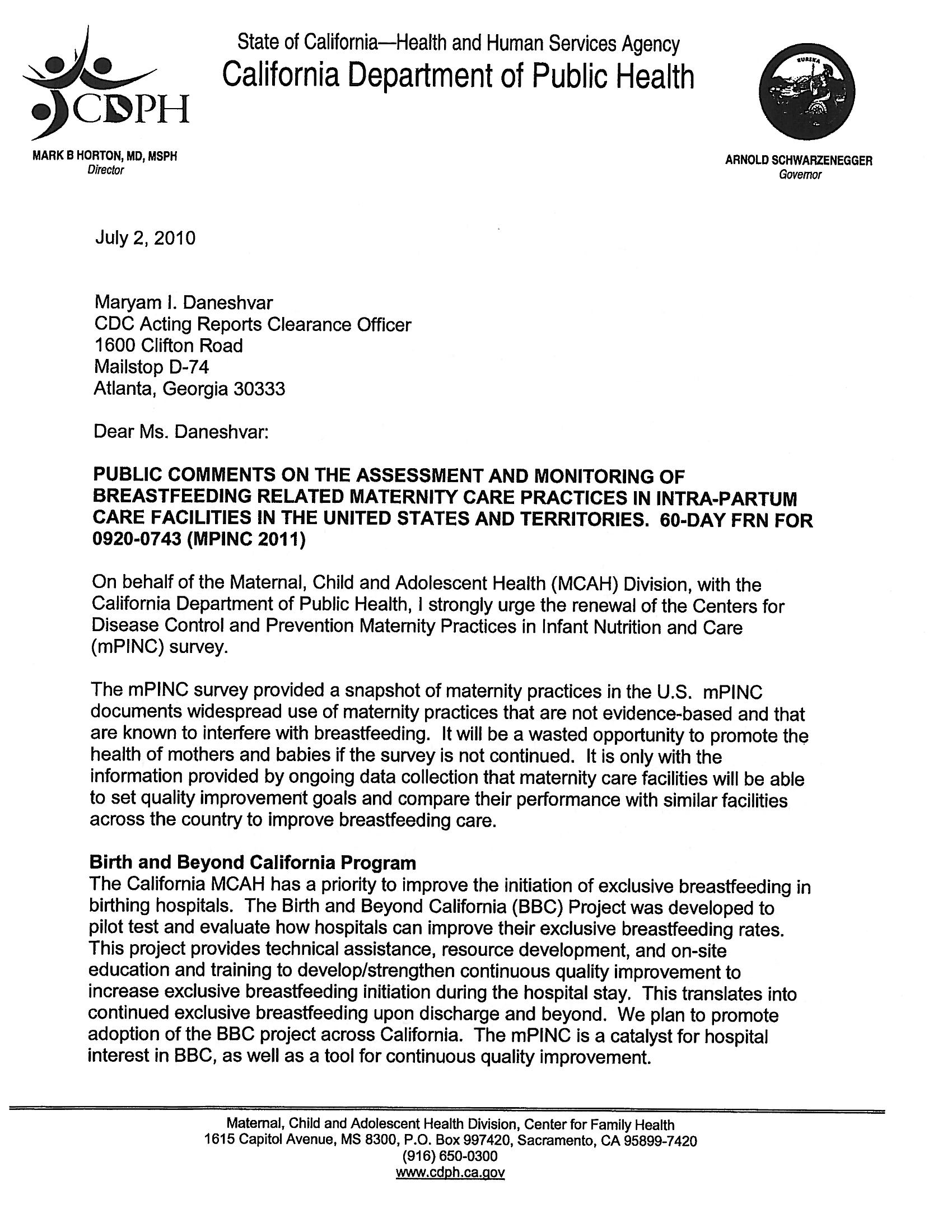
Public Comment #11
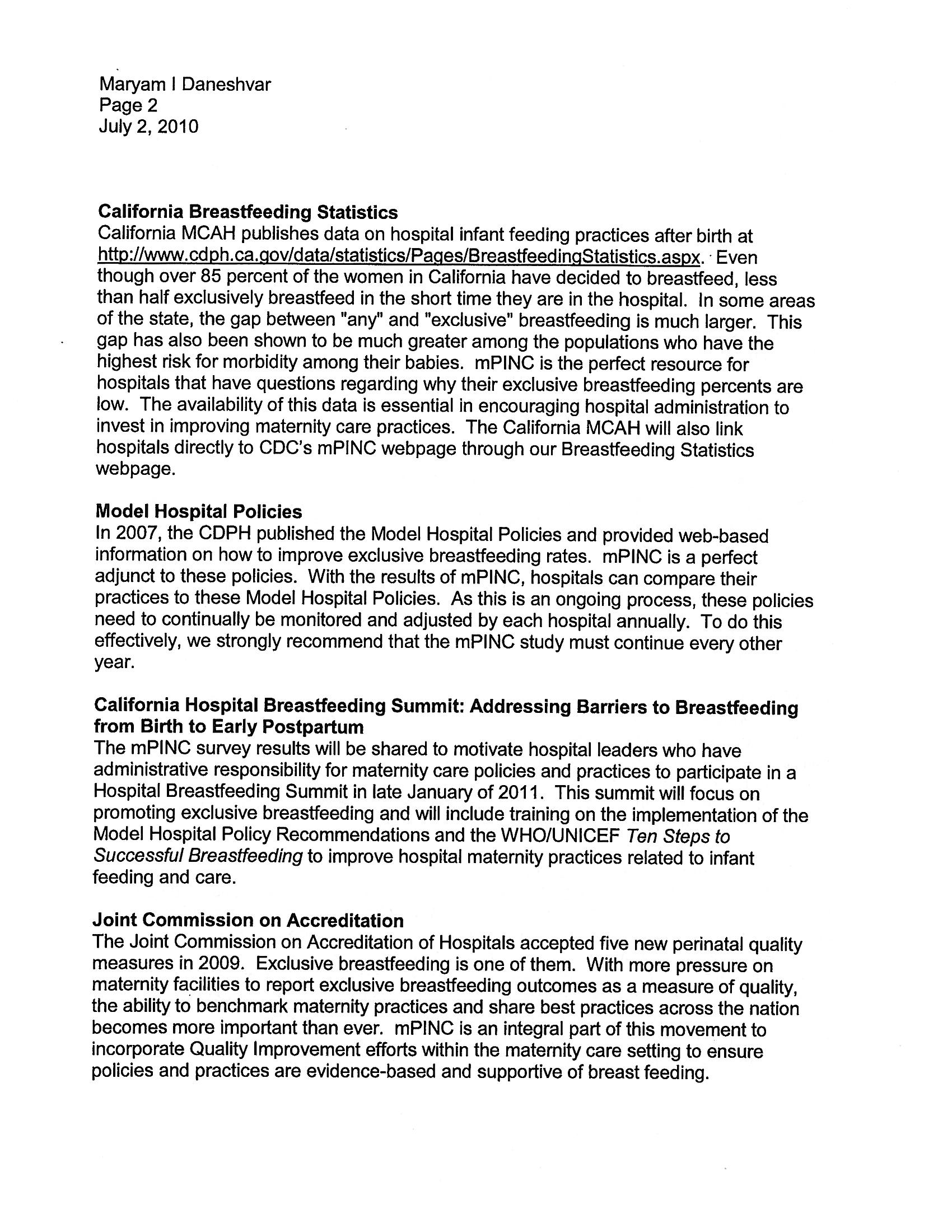
Public Comment #11
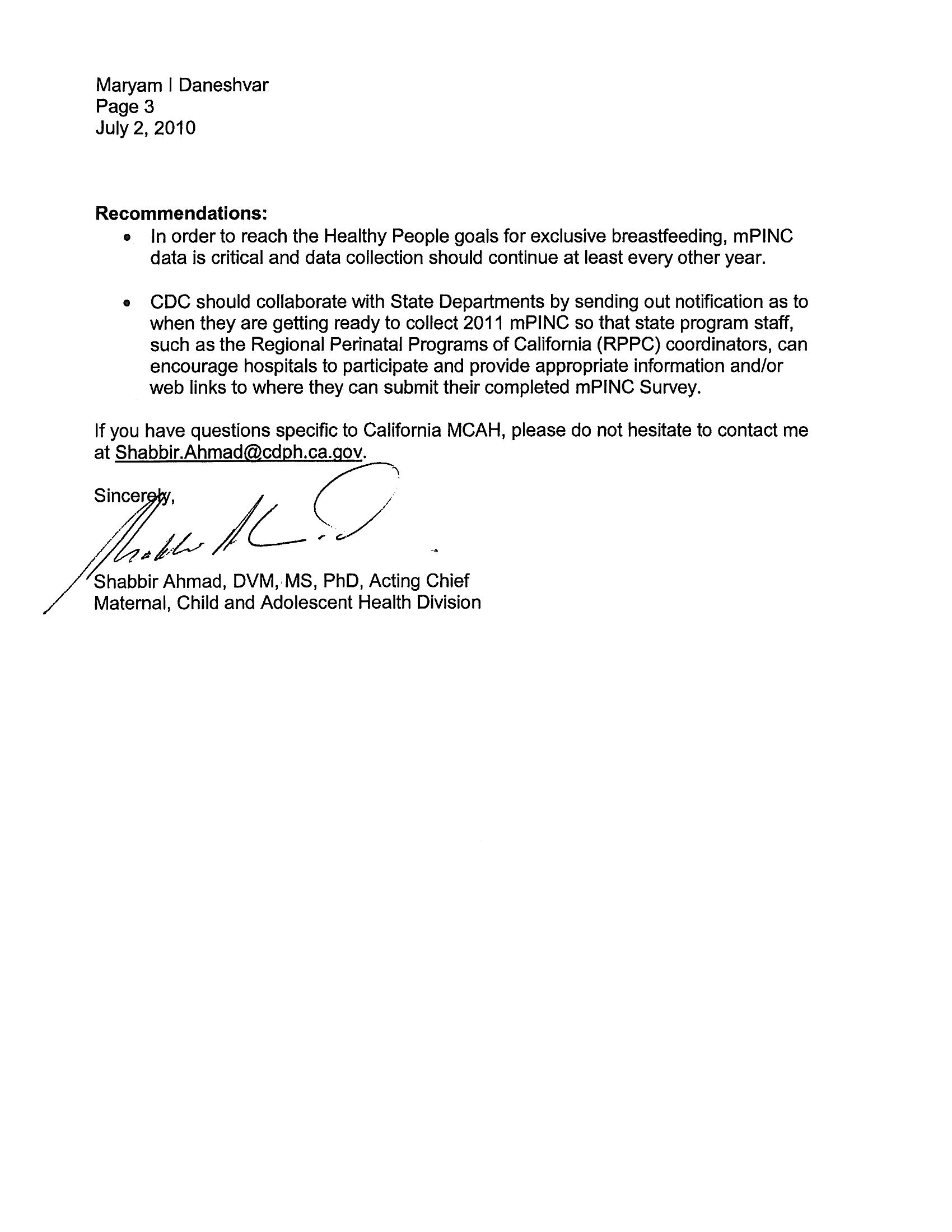
Public Comment #12
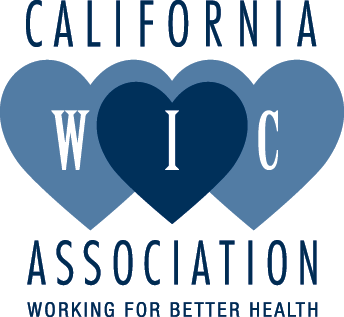
Public Comments on the Assessment and Monitoring of Breastfeeding-Related Maternity Care Practices in Intra-partum Care Facilities in the United States and Territories Publication of the 60-day FRN for 0920-0743 (mPINC 2011)
July 7, 2010
Maryam I. Daneshvar,
CDC Acting Reports Clearance Officer,
1600 Clifton Road, MS D-74,
Atlanta, GA 30333
Telephone: 404-639-5960
Email: [email protected]
On behalf of the California WIC Association, we are writing again, (2009 also), in strong support of the renewal of the Centers for Disease Control and Prevention Maternity Practices in Infant Nutrition and Care (mPINC) 2011 survey. These reports have been very useful in California communities by providing hospitals and birthing centers with important information for improving maternity practices. We are in meetings all the time when mPINC studies are referenced in relation to improving breastfeeding practices.
With the The Joint Commission Perinatal Care Core Measure on Exclusive Breast Milk Feeding, the mPINC report is even more valuable, and provides the ability to benchmark maternity practices and share best practices across the nation.
The California WIC Association, in partnership with the Human Lactation Center at the University of California Davis, has produced three reports on hospital breastfeeding rates, and will release another in October 2010, using publicly available data. These reports have been instrumental in more hospitals either becoming baby friendly or adopting model hospital breastfeeding policies, recommended by the California Department of Public Health. We committed to multi-year reports in order to maintain the momentum of change. Hospital staff, breastfeeding advocates and WIC staff welcome these reports as useful and effective tools for implementing changes in hospital policies. The mPINC study will be most effective if it remains a multi-year report.
![]()
Not all states have access to the breastfeeding data that is available for California hospitals. We are fortunate to the commitment of the Maternal Child and Adolescent Health Division in the California Department of Public Health to provide data . The mPINC study provides hospitals in all states with useful maternity practice data that empowers hospital staff to work on quality of care improvement.
In order to reach our national breastfeeding goals, our hospitals need information, like that provided in the mPINC reports, on their maternity practices that support breastfeeding.
Karen Farley RD, IBCLC
Public Comment #13

July 7, 2010
Maryam I. Daneshvar,
CDC Acting Reports Clearance Officer
1600 Clifton Road, MS D-74,
Atlanta, GA 30333
Email: [email protected]
RE: Public Comments [60 Day-10-0743] on the Assessment and Monitoring of
Breastfeeding-Related Maternity Care Practices in Intra-partum Care Facilities in the
United States and Territories (OMB Control No. 0920-0743, Exp. 10/31/2010)
On behalf of the California Breastfeeding Coalition (CBC), I strongly urge the renewal of the
Centers for Disease Control and Prevention Maternity Practices in Infant Nutrition and Care
(mPINC) survey. As you know, despite governmental recommendations, mounting scientific
evidence, and national promotion campaigns, breastfeeding rates in the United States continue to
fall short of national goals. Assessing and monitoring of breastfeeding-related maternity care
practices in the hospitals highlights their policies and practices to support breastfeeding in the
early postpartum period.
While completing the initial mPINC survey provided a snapshot of maternity practices in the U.S.
(and found widespread use of maternity practices that are not evidence-based and that are
known to interfere with breastfeeding) it will be a wasted opportunity to promote the health of
mothers and babies if the survey is not continued. It is only with the information provided by
ongoing data collection that maternity care facilities will be able to set quality improvement goals
and benchmark with similar facilities across the country to improve breastfeeding care.
The California Department of Public Health is in the process of releasing the California mPINC
results by regions. This information is extremely valuable to groups like ours that advocate for
hospitals to implement Model Hospital Policies or Baby-Friendly policies to support breastfeeding
mothers. The CBC and our local breastfeeding coalitions welcome these survey results in multiyears
to measure change and to have effective tools for effecting changes in hospitals policies.
Again, I strongly urge the renewal of the mPINC survey and look forward to its continuance for
local change.
Please don’t hesitate to contact me if I can answer any questions.
Sincerely,
Robbie Gonzalez-Dow, MPH, RD
Executive Director
California Breastfeeding Coalition
Phone: 831-917-8939
Email: [email protected]
Public Comment #14
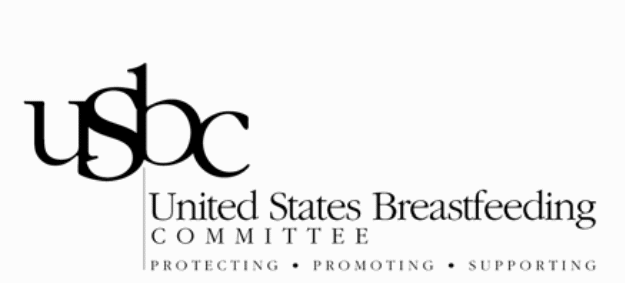
July 9, 2010
To Whom It May Concern:
On behalf the United States Breastfeeding Committee (USBC), I strongly urge the renewal of the Centers for Disease Control and Prevention Maternity Practices in Infant Nutrition and Care (mPINC) survey. As you know, despite governmental recommendations, national health outcome targets, mounting scientific evidence, and national promotion campaigns, breastfeeding rates in the United States continue to fall short of national goals.
While completing the initial mPINC survey provided a snapshot of maternity practices in the U.S. (and found widespread use of maternity practices that are not evidence‐based and are known to interfere with breastfeeding), it will be a waste of taxpayer money and a wasted opportunity to promote the health of mothers and babies if the survey is not continued. It is only with the information provided by ongoing data collection that maternity care facilities will be able to set quality improvement goals and benchmark with similar facilities in their states and across the country to improve breastfeeding care.
Of particular note is that The Joint Commission’s Perinatal Care Core Measure Set requires quality improvement relative to “exclusive breast milk feeding at hospital discharge.” With more pressure on maternity facilities to report breastfeeding outcomes as a measure of quality, the ability to benchmark maternity practices and share best practices across the nation becomes more important than ever.
The USBC is a collaborative coalition of organizations, representing governmental agencies, non‐governmental organizations, and health professional associations. Guided by its mission to improve the Nation’s health by working collaboratively to protect, promote, and support breastfeeding, USBC continues to work to achieve the Healthy People 2010 national breastfeeding goals.
Please don’t hesitate to contact me if I can answer any questions.
Sincerely,
Joan Younger Meek, MD, MS, RD, FAAP, FABM, IBCLC
Chair
United States Breastfeeding Committee
2025 M Street, NW, Suite 800 ▪ Washington DC 20036 ▪ Phone: (202) 367-1132 ▪ FAX: (202) 367-2132
E-mail: [email protected] ▪ Web site: www.usbreastfeeding.org
| File Type | application/vnd.openxmlformats-officedocument.wordprocessingml.document |
| Author | arp5 |
| File Modified | 0000-00-00 |
| File Created | 2021-02-01 |
© 2026 OMB.report | Privacy Policy